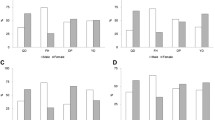Abstract
Objective
To explore the influence of Chinese medicine constitution type on the susceptibility of hypertensive patients to intracerebral haemorrhage.
Methods
Primary hypertensive patients were studied and divided into the hypertension and the hypertensive intracerebral haemorrhage groups, depending on whether or not the patients had intracerebral haemorrhage. The demographic characteristics, physiological characteristics, living habits, biochemical tests, other chronic diseases, Chinese medicine constitution type, etc. were collected and compared between the two groups. The neurological deficit in the hypertensive intracerebral haemorrhage group was also compared among the different constitution types.
Results
A total of 304 patients participated in this investigation, including 213 cases in the hypertension group and 91 cases in the hypertensive intracerebral haemorrhage group. The percentages of dampness-heat and qi-depression types in the intracerebral haemorrhage group were greater than those with the same types in the hypertension group (20.9% vs 6.1%, 22.0% vs 8.0%; P<0.05). The percentages of each constitution type were different between genders in both groups. In addition, there were more male cases (14/20) with qi-depression type and more female cases (7/8) with phlegm-dampness type in the hypertensive intracerebral haemorrhage group than those with the same types (3/17 and 9/34, respectively) in the hypertension group (P<0.05). The cases with phlegm-dampness and qi-depression types had greater levels of blood lipids in the intracerebral haemorrhage group than those with the same types in the hypertension group (P<0.05). Furthermore, the cases with the qi-deficiency type presented with a more severe neurological deficit than those with the other types (P<0.05).
Conclusions
Chinese medicine constitution type might have an impact on the susceptibility of hypertensive patients to have an intracerebral haemorrhage. The heat-dampness and qi-depression types might lead to greater susceptibility than the other types. In addition, the patient’s gender and blood lipids might also influence the susceptibility along with the constitution type.
Similar content being viewed by others
References
Wang Q. Classification and diagnosis basis of nine basic constitutions in Chinese medicine. J Beijing Univ Tradit Chin Med (Chin) 2005;28(4):1–8.
Disease Prevention and Control Bureau Ministry of Health, Chinese Medical Association neuropathy credits. China guideline for cerebrovascular disease prevention and treatment. Beijing: People’s Health Publishing House; 2007:3.
Liu LS, Wang W, Yao CH. Guidelines for the prevention and treatment of hypertension in China. Chin J Hypertens (Chin) 2010;18:11–30.
Disease Prevention and Control Department, Ministry of Health, Neurology Branch of Chinese Medical Association. China guideline for cerebrovascular disease prevention and treatment. Beijing: People’s Medical Publishing House; 2007:35–40.
China association of Chinese Medicine. Determination and classification of the constitution of traditional Chinese medicine. World J Integr Tradit West Med (Chin) 2009;4:303–304.
Chen XC, Pan XD. Handbook of neurologic examination and assessment scales. Beijing: Chemical Industry Press; 2013:86–120.
Evans BC, Belyea MJ, Coon DW, Ume E. Activities of daily living in Mexican American caregivers: the key to continuing informal care. J Fam Nurs 2012;18:439–466.
van Swieten JC, Koudstaal PJ, Visser MC, Schouten HJA, van Gijn J. Interobserver agreement for the assessment of handicap in stroke patients. Stroke 1988;19:604–607.
Lindenstrøm E, Boysen G, Waage CL, à Rogvi HB, Würtzen NP. Reliability of scandinavian neurological stroke scale. Cerebrovasc Dis 1991;1:103–107.
Wang Q, Zhu YB. Epidemiological investigation of constitutional types of Chinese medicine in general population: Base on 21,948 epidemiological investigation data of nine provinces in China. China J Tradit Chin Med Pharm (Chin) 2009;24:7–12.
Zhu YB, Wang Q, Deng QW, Cai J, Song XH, Yan X. Relationships between constitutional types of traditional Chinese medicine and hypertension. J Chin Integr Med (Chin) 2010;8:40–45.
Wang Q, Ren XJ, Yao SL, Wu HD. Clinical observation on the endocrinal and immune functions in subjects with yin-deficiency constitution. Chin J Integr Med 2010;16:28–32.
Feng YL, Zheng GY, Ling CQ. The investigation of the correlation between metabolic syndrome and Chinese Medicine constitution types in senior retired military personnel of the people’s liberation army. Chin J Integr Med 2012;18:485–489.
Xu XP, Yan ZS, Wu LJ, Fang GZ, Wang MJ, Chen D, et al. Traditional Chinese medicine cultivate sentiment of qidepression constitution intervention study and evaluation. Zhejiang J Tradit Chin Med (Chin) 2010;45:490–491.
Liu Y, Chen KJ. Atherosclerosis, vascular aging and therapeutic strategies. Chin J Integr Med 2012;18:83–87.
Bozluolcay M, Nalbantoglu M, Gozubatik-Celik RG, Benbir G, Akalin MA, Erkol G. Hypercholesterolemia as one of the risk factors of intracerebral hemorrhage. Acta Neurol Belg 2013;113:459–462.
Author information
Authors and Affiliations
Corresponding author
Rights and permissions
About this article
Cite this article
Han, Sh., Zheng, Jm., Li, Kz. et al. Influence of traditional Chinese medicine constitution type on the susceptibility of hypertensive cases to intracerebral haemorrhage. Chin. J. Integr. Med. 20, 923–927 (2014). https://doi.org/10.1007/s11655-014-1711-z
Received:
Published:
Issue Date:
DOI: https://doi.org/10.1007/s11655-014-1711-z



